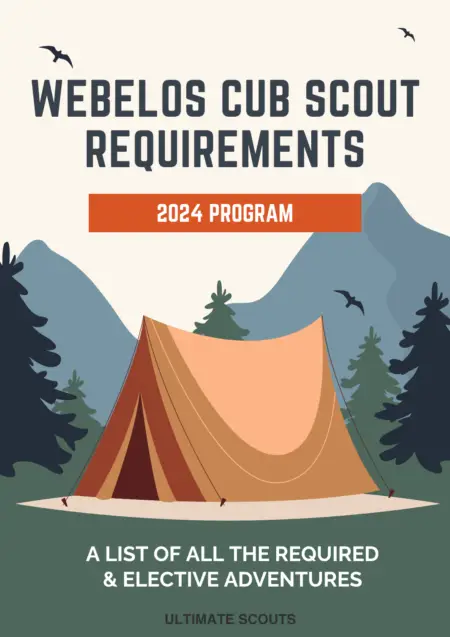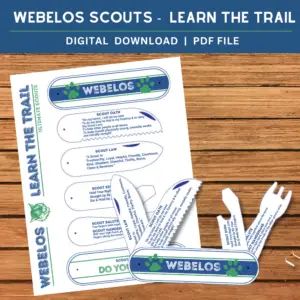What Are The Webelos Requirements? (2024)
What Are The Webelos Requirements? (2024)
Starting June 2024 the Webelos Scouts will be asked to do 6 of the Required Adventures and 2 of the over a dozen Elective Adventures now being offered to earn their Webelos Rank

Webelos Cub Scout - Required Adventures
The following 6 Adventures are required for a Webelos Scout to receive achieve Webelos rank. You can see all the details in the Webelos Scout Handbook. If you are looking for a quick way to see all of the adventures and requirements we have created a printable “cheat sheet” that gives a quick overview of all the activities that can be placed in your Scout Binder for quick reference.
- Get to know members of your den.
- Recite the Scout Oath & Scout Law with your den & den leader. Describe 3 points of the Scout Oath.
- Learn about the Scout Law.
- With your den create a Code of Conduct.
- Learn about the Denner position & responsibilities
- Demonstrate the Cub Scout Sign, Salute, & handshake. Show how each is used.
- At home with a parent or legal guardian, do the activities in the booklet “How to Protect Your Children from Child Abuse: A Parent’s Guide.”
Webelos Walkabout
- Prepare for a 2-mile walk outside. Gather your Cub Scout 6 Essentials & weather-appropriate clothing & shoes.
- Plan a 2-mile route for your walk.
- Check the weather forecast for the time of your planned hike.
- Review the 4 points of the BSA SAFE Checklist & how you will apply them on your 2-mile hike.
- Demonstrate first aid for the following events that could happen on your walk: Blister, sprained ankle, sunburn, dehydration & heart-related illness.
- With your den, pack, or family, Go on your 2-mile walk while practicing the leave no trace principles for kids & outdoor code.
- After your walk, discuss with your den What went well and what you would do differently next time.
- Learn about majority & plurality types of voting.
- Speak with someone who is elected to their position. Discover the type of voting that was used to elect them & why.
- Choose a federal law & create a timeline of the history of the law. Include the involvement of the 3 branches of government.
- Participate in a service project.
- With your parent or legal guardian talk about your family’s faith traditions. Identify 3 holidays or celebrations that are part of your family’s faith traditions. Make a craft, work of art, or food item that is part of your favorite family’s faith tradition holiday or celebration.
- Carry out an act of kindness.
- With your parent or legal guardian identify a religion or faith that is different than yours. Identify 2 things that it has in common with your family’s beliefs.
- Discuss with your parent or legal guardian what it means to be reverent. Tell how you practice being reverent in your daily life.
- With permission from your parent or legal guardian, watch the “Protect Yourself Rules” video for the webelos rank.
- Identify items in your house that are hazardous & make sure they are stored properly. Identify on the package where it describes what to do if someone is accidentally exposed to them.
- Identify ways you and your family keep your home 0r meeting space safe.
- Complete the “Be Prepared For Natural Events” worksheet. Complete a worksheet for at least 2 natural events most likely to happen near where you live.
- With your den or family, plan, cook, & eat a balanced meal.
- Be active for 30 minutes with your den or at least one other person in a way that includes both stretching & moving.
- Be active for 15 minutes doing personal exercises to boost your heart rate, use your muscles, & work on flexibility.
- Do a relaxing activity for 10 minutes.
- Review your BSA annual Health & Medical record with your parent or guardian. discuss your ability to participate in den or pack activities.
Webelos Cub Scout Elective Adventure
The following Adventures are elective and only 2 are required to be completed to earn the Webelos rank. All of the adventures are broken down in the Webelos Scout Handbook.
- Create a piece of art by exploring drawing techniques using pencils.
- Using a digital image, explore the effects of filters by changing an image using different editing or in-camera techniques.
- Create a piece of art using paint as your medium.
- create a piece of art combining at least 2 mediums.
- State the safety precautions you need to take before doing any swimming activity.
- Explain the meaning of “order of rescue” & demonstrate the reach & throw rescue techniques from land.
- Learn how to treat & prevent hypothermia.
- Attempt to tread water.
- Attempt the BSA Swimmer Test.
- Have 30 minutes or more of free swim time where you practice the buddy system & stay within your ability group. The qualified adult supervision should conduct at least 3 buddy checks per half-hour of swimming.
- Do an activity that shows the challenges of being visually impaired.
- Do an activity that shows the challenges of being hearing impaired.
- Explore barriers to access.
- Meet someone who has a disability or someone who works with people with disabilities about what obstacles they had to overcome and how they do it.
- Learn about some basic tools & the proper use of each tool. Learn about & understand the need for safety when you work with tools.
- Demonstrate how to check for plumb, level, & square when building.
- With the guidance of your den leader, parent, or guardian, select a carpentry project that requires it to be either plumb, level, and/or square. Create A list of materials & tools you will need to complete the project.
- Build your own carpentry project.
- Make a plan to go fishing. Determine where you will go & what type of fish you plan to catch. All of the following requirements are to be completed based on your choice.
- Use the BSA SAFE checklist to plan what you need for your fishing experience.
- Describe the environment where the fish might be found.
- Make a list of the equipment & materials you will need to fish.
- Determine the best type of knot to tie your hook to your line & tie it.
- Choose the appropriate type of fishing rod & tackle you will be using. Have an adult review your gear.
- Using what you have learned about fish & fishing equipment, spend at least 1-hour fishing following your local guidelines & regulations.
- Explore the 4 components that make up a habitat: food, water, shelter, & space.
- Pick an animal that is currently threatened or endangered to complete requirements 3, 4, & 5.
- Identify the characteristics that classify an animal as a threatened or endangered species.
- Explore what caused this animal to be threatened or endangered.
- Research what is currently being done to protect the animal.
- Participate in a conservation project.
- Read, understand, and promise to follow the Cub Scout Knife Safety rules.
- Demonstrate the knife safety circle.
- Demonstrate that you know how to care for & use a kitchen knife safely.
- Choose the correct cooking knife & demonstrate how to properly slice, dice, & mince.
- Examine the 3 types of rocks: sedimentary, igneous, & metamorphic.
- Find a rock, safely break it apart & examine it.
- Make a mineral test kit, & test minerals according to the Mohs scale of mineral hardness. Using the Rock Cycle chart or one like it, discuss how hardness determines which materials can be used in homes, landscapes, or for recreation.
- Grow A Crystal.
- With your den, pack, or family, plan & participate in a campout.
- Upon arrival at the campground, determine where to set up a tent.
- Set up a tent without help from an adult.
- Identify a potential weather hazard that could occur in your area. Determine the action you will take if you experience a weather hazard during the campout.
- Show how to tie a bowline. Explain when this knot should be used and why.
- know the fire safety rules. Using those rules, locate a safe area to build a campfire.
- Using tinder, kindling, and fuel wood properly build a teepee fire lay. If circumstances permit & there is no local restriction on fires, show how to safely light the fire while under adult supervision. After allowing the fire to burn safely, extinguish the flames with minimal impact to the fire site.
- Recite the Outdoor Code & the Leave No Trace Principles for Kids from memory.
- After your campout, share the things you did to follow the Outdoor Code & Leave No Trace Principles for Kids with your den or family.
- Determine your walking pace by walking 1/4 mile. Project how long it would take you to walk 2 miles.
- Walk 2 miles & record the time it took you to complete the 2 miles.
- Project how long it would take you to hike a 20-mile trail over 2 days. list all the factors to consider for your projection.
- Learn what modular design is & identify 3 things that use modular design in their construction.
- Using modular-based building pieces, build a model without a set of instructions.
- Using the model made in requirement 2, create a set of step-by-step instructions on how to make your model.
- Have someone make your model using your instructions.
- Using the same modular pieces used in Requirement 2, build another model of something different.
- With your parent or legal guardian’s permission, watch a video demonstrating how something was built using modular design
- Before attempting requirements 5, 6, 7, 8, & 9 for this adventure, you must pass the BSA swimmer test.
- Pick a paddle craft for which to complete all requirements: canoe, kayak, or stand-up paddleboard (SUP)
- Review Safety afloat.
- Demonstrate how to choose & properly wear a life jacket that is the correct size.
- Jump feet first into water over your head while wearing a life jacket. Then swim 25 feet wearing the life jacket.
- Demonstrate how to enter & exit a canoe, kayak, or SUP safely.
- Discuss what to do if your canoe or kayak tips over or you fall off your SUP.
- Learn how to pick a paddle that is the right size for you. Explore how the paddle craft responds to moving the paddle.
- Have 30 minutes or more of time using your watercraft.
- Decide on gear & supplies you should bring for a long bike ride.
- Discover how multi-gear bicycles work & how they benefit a rider.
- Practice how to lubricate a chain.
- Pick a bicycle lock that you will use. Demonstrate how it locks & unlocks, how it secures your bicycle, & how you carry it while you are riding your bicycle.
- With your family, den, or pack, Use a map & plan a bicycle ride that is at least 5 miles.
- With your den, pack, or buddy, go on a bicycle ride that is a minimum of 5 miles.
- With your Adult Partner, assemble & decorate either a pinewood derby car or a raingutter regatta.
- Learn the rules of the race for the vehicle chosen in Requirement 1.
- Explore the properties of friction & how it impacts your chosen vehicle.
- Before the race, discuss with your den how you will demonstrate good sportsmanship during the race.
- Participate in a pinewood derby or regatta race.
- Discuss how tech can keep you safe in the outdoors.
- Explore Global Positioning System (GPS) devices & how to use them.
- With an adult, choose an online mapping program tool and plan a 2-mile hike.
- Take Your 2-mile hike.
- During the months May- August participate in a total of 3 Cub Scout activities.
- Learn the safety rules of using a yo-yo & follow them at all times.
- Discover how to find the proper yo-yo string length for you.
- Explain why it is important to have the correct string length and to be in the right location before throwing a yo-yo.
- Demonstrate how to properly string a yo-yo and how to create a slip knot.
- conduct the pendulum experiment with a yo-yo. Explain what happens to the yo-yo when the string is longer.
- Show that you can properly wind a yo-yo.
- Attempt Each of the following: gravity pull, sleeper, breakaway
- Identify & wear the appropriate safety gear.
- Recite the archery range safety rules & whistle commands.
- Demonstrate proper range commands.
- Identify the main parts of your shooting equipment & How to properly use them.
- Demonstrate proper stance & shooting techniques.
- Shoot 5 arrows at a target. repeat 4 times & do your best to improve your score. Shoot at least 20 arrows.
- Demonstrate how to safely retrieve your arrows.
- Discuss how to put away & properly store your archery shooting equipment after use.
- Recite the 4 safety reminders.
- Identify and wear the appropriate safety gear.
- Demonstrate proper range commands.
- Show how to use the safety mechanism.
- Demonstrate how to properly load, fire, & secure your bb gun.
- Demonstrate one of the positions for shooting a bb gun.
- Fire 5 BB’s at the target. With the help of your AP score your target. Repeat 3 times and do your best to improve your score. Fire at least 20 BB’s.
- Discuss how to put away & properly store your BB gun & shooting equipment after use.
- Identify & wear the appropriate safety gear.
- Recite the archery range safety rules for using a slingshot.
- Demonstrate proper range commands.
- Identify the main parts of your slingshot & their usage.
- Discover the types of ammunition that may be used & not used.
- Shoot 5 shots at a target. repeat 2 times & do your best to improve your score. Shoot at least 15 shots.
- Discuss how to put away & properly store your slingshot & shooting equipment after use.


